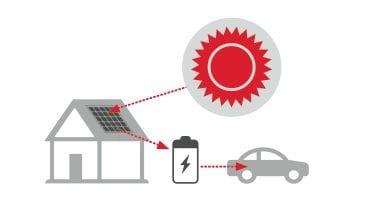On of the four scenarios laid out by the CSIRO’s Future Grid story was leaving the grid. Even for those customers located in the city. As mentioned in our main story, CSIRO suggested one third on consumers could go off-grid by 2050, based around the prospect that it would be economic to do so from around 2030 onwards.
But the CSIRO concedes that the economics for people to go off-grid may come sooner than that – even a decade earlier. Given that it is one of the questions most often put to RenewEconomy by its readers, we thought we would publish the CSIRO’s comment on this scenario in its entirety.
“The proposed Scenario 3: ‘Leaving the grid’ imagines a large number of customers taking full responsibility for reliably meeting their own electricity demand through complete disconnection, and deploying on-site generation and electricity management systems. Those disconnected would not be able to maintain a link to the grid in case of back-up because they would have to pay for that link, which would void their motivation (independence and cost reduction) for being disconnected.
BUT HOW ECONOMICALLY VIABLE IS FULL DISCONNECTION?
For commercial or industrial customers with sufficient roof space, solar panels with batteries might be feasible; otherwise micro or cogeneration systems utilising gas, biomass, diesel or coal (depending on cost and distribution constraints) would also allow disconnection. Small-scale engines or turbines are well suited to load-following and are a complete technical solution, but there are some limitations.
First, these customers essentially become reliant on another type of grid (fuel distribution grids). Second, costs may be prohibitive depending on their load profile. They would need to size their plant to their peak demand. If the difference in their peak-to-minimum demand is very large then the plant will achieve a low utilisation of capital, which may result in a prohibitively high unit cost of electricity. Third, given fossil fuel and carbon prices are expected to rise over time, plant running costs would be expected to increase (for those that are liable for greenhouse gas emissions in any given future scheme).
Microgeneration systems also would be technically viable options for residential and small commercial consumers, but they are generally more expensive at smaller scale and would be subject to the same limitations.
For Scenario 3: ‘Leaving the grid’, the Forum considered solar photovoltaic panels for the main on-site electricity source because they
are most in keeping with the scenario theme of independence, particularly for households. The major challenge with solar panels would be to manage electricity supply from the panels with battery storage to cover general variability, non- daylight load and temporary cloudy periods.The battery system would need to be sized for all of the demand that is non-coincident with solar output and also take into account round-trip efficiency of 70 per cent and 80 per cent useful charge range.
Hot water heating would be relatively straightforward to arrange during the day given it has built-in thermal storage, but a more sophisticated demand control system would be required to shift the loads of other appliances. Ultimately, there would be a limit to what can be shifted and any demand control systems would need to be included in total system costs.The battery and solar systems would need to be sized to meet daily energy consumption and peak load (when most appliances are switched on). Households that have large air-conditioning systems, pool pumps or other large power devices would need larger systems.
During extended solar panel outages or unfavourable weather, it would be cost-prohibitive to rely solely on battery storage capacity. Instead, it would make sense to rely on some sort of generator using petrol, diesel or gas. Households with high power needs might factor in being able to use their generator for occasional periods where the demand is very high. Biodiesel would be a potential solution to maintain the environmental values of the installation. Local council regulations, however, might prohibit generators if they produce significant noise and local air pollution.
If the consumer also wants to charge an electric vehicle, they would need a system capable of storing and charging typically an extra 6 kilowatt hours a day or have access to public recharging. This does not increase the unit cost of electricity for the installation but might, if it’s not already doing so, press the limits of roof space. For the purposes of Scenario 3, modelling allows for the potential development of alternative organic or structural photovoltaic panels which would increase the surface of the house available for electricity generation.
Sensitivity testing of different levels of household consumption (Graham et al 2013b) estimates the current cost of household disconnection to be 92–118 cents per kilowatt hour. Based on a number of studies discussed earlier, the Forum assumed a 50 per cent reduction in storage costs by 2030. As a result, disconnection is projected to cost 42–53 cents per kilowatt hour by 2030. Assuming a 75 per cent reduction in costs relative to 2013, by 2050, the cost of disconnection is projected to be 20–24 cents per kilowatt hour.15 On the basis of these assumptions, disconnection will not be economically viable until after 2030, but would be before 2050 under retail cost projections.”











